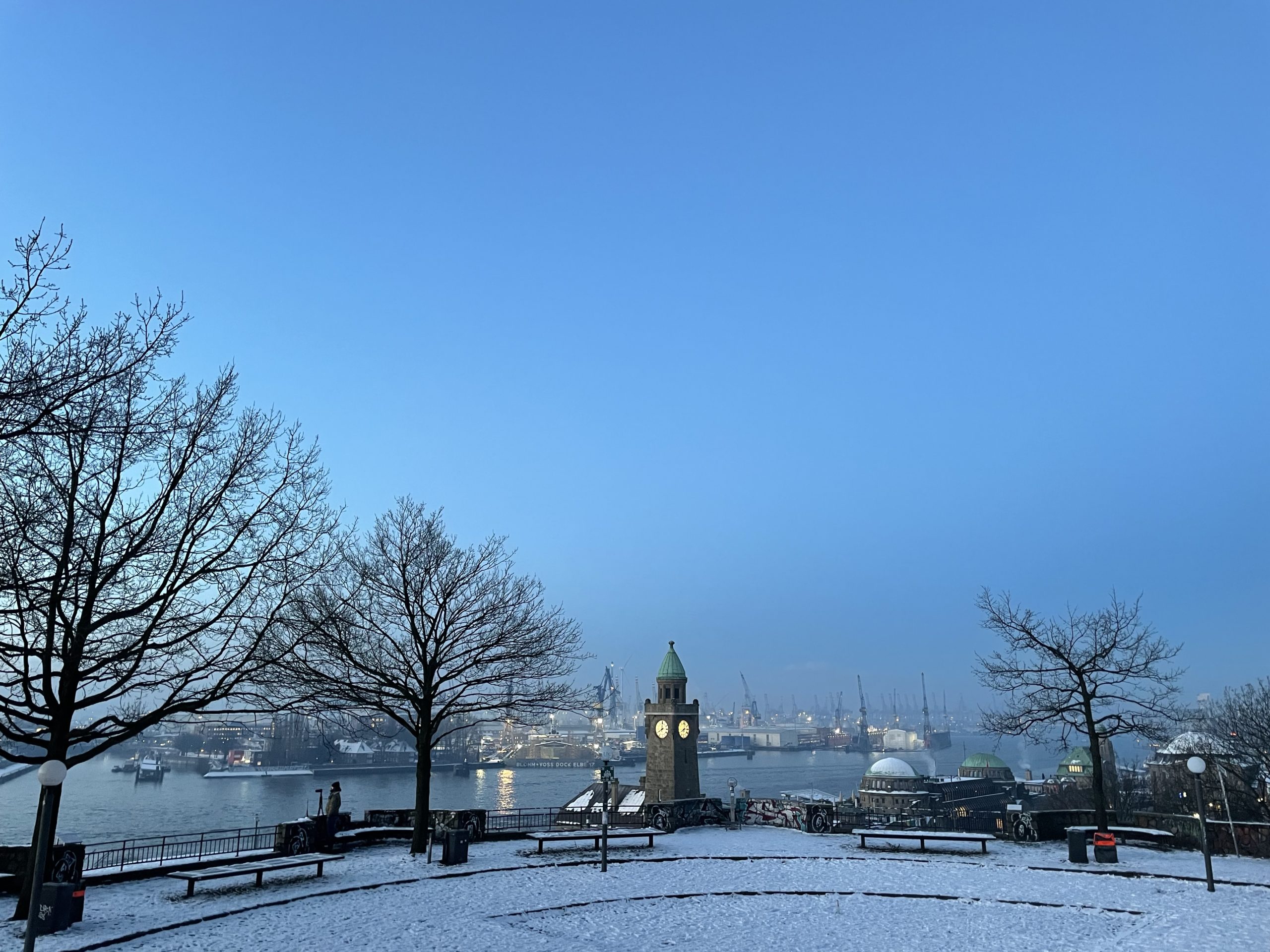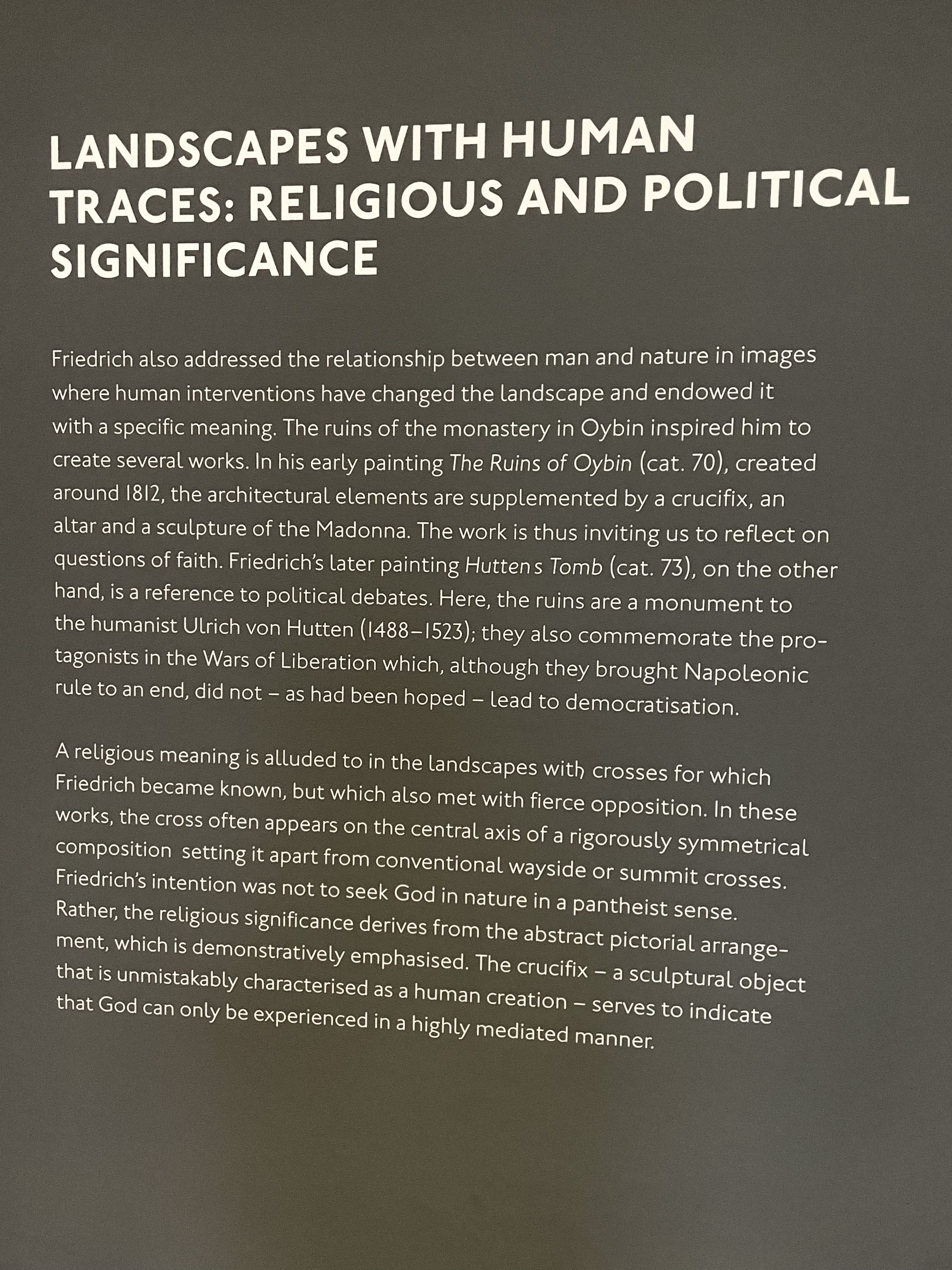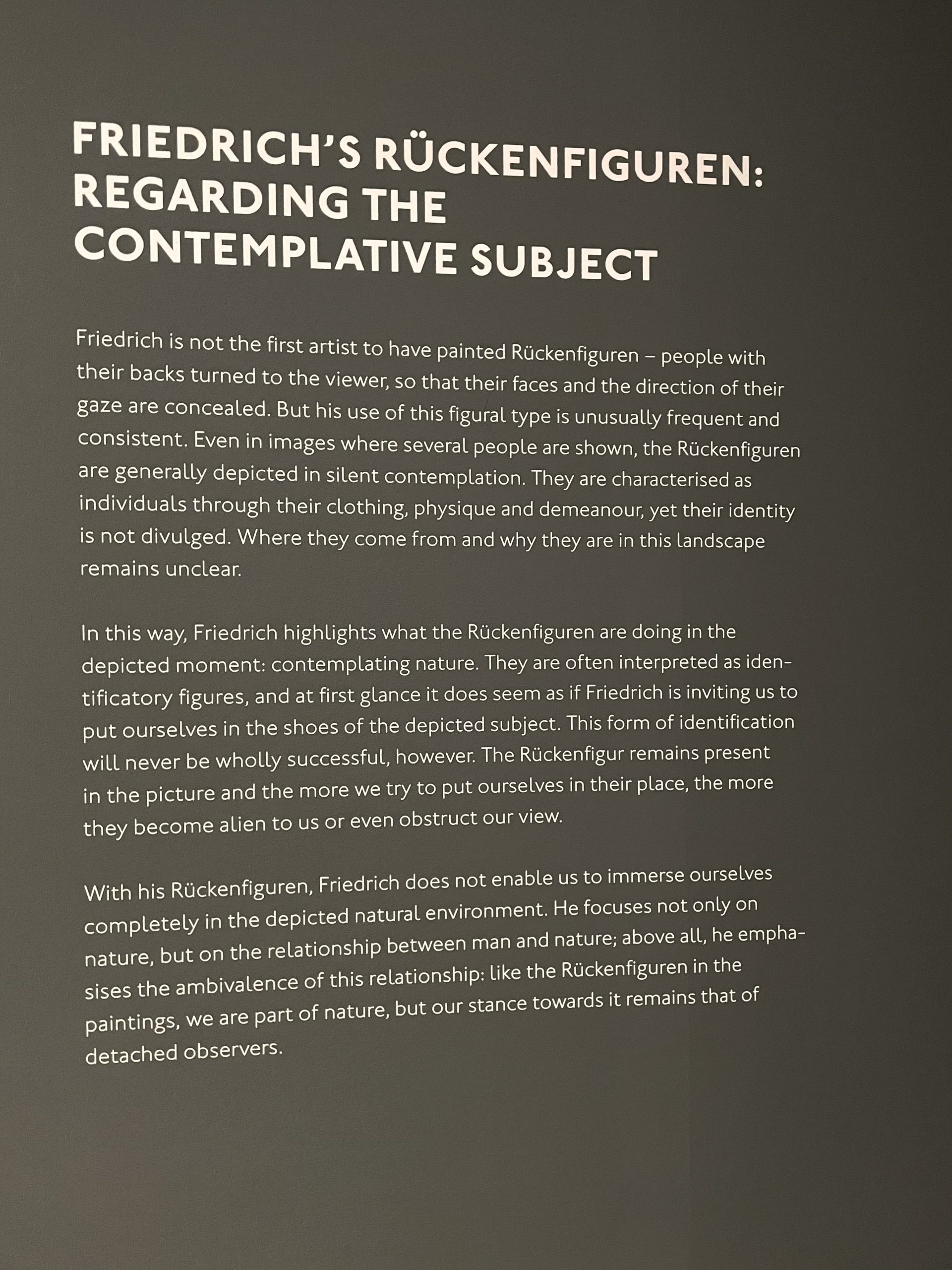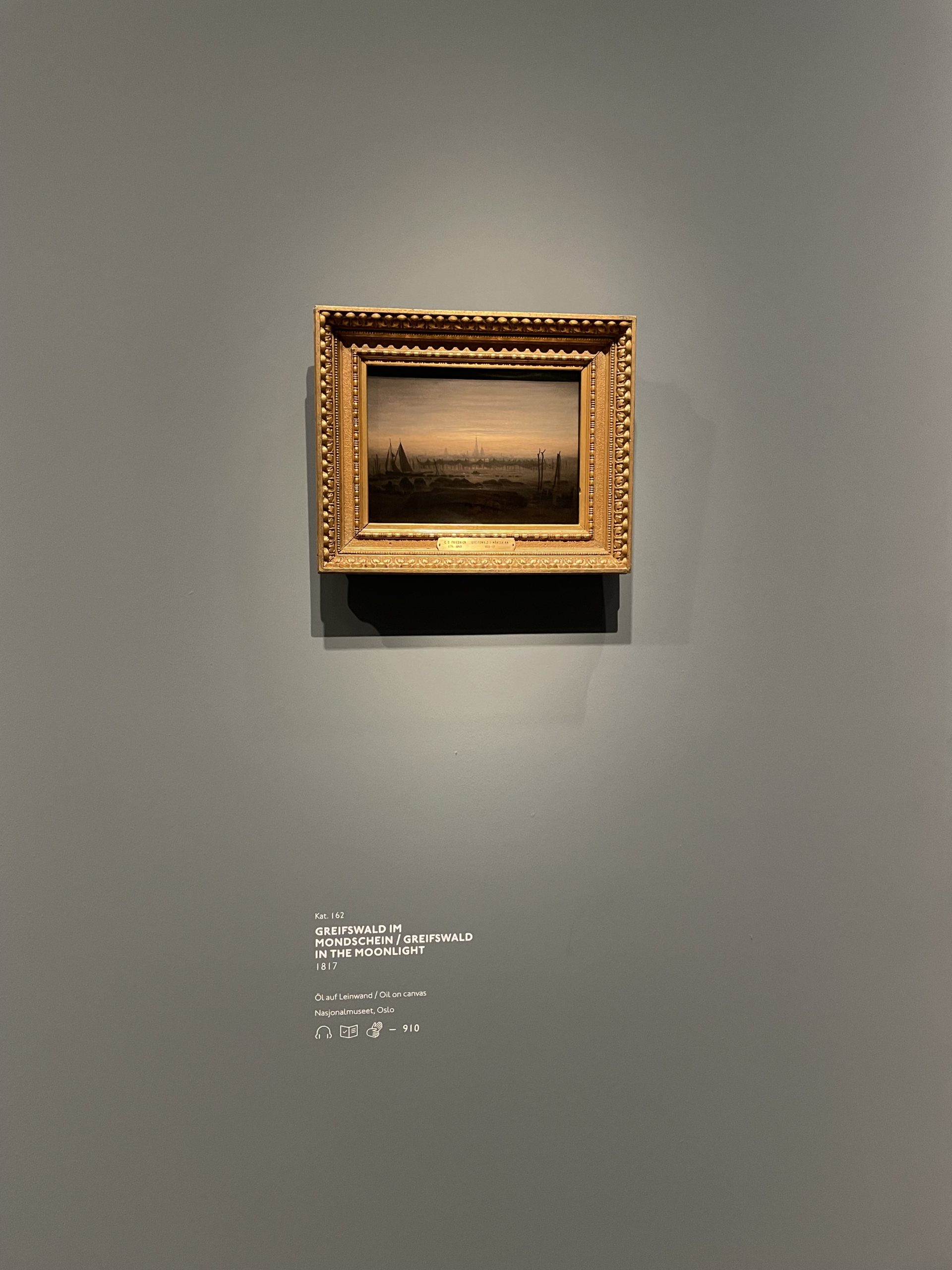




LANDSCAPES WITH HUMAN
TRACES: RELIGIOUS AND POLITICAL
SIGNIFICANCE
Friedrich also addressed the relationship between man and nature in images where human interventions have changed the landscape and endowed it with a specific meaning. The ruins of the monastery in Oybin inspired him to create several works. In his early painting The Ruins of Oybin (cat. 70), created around 1812, the architectural elements are supplemented by a crucifix, an altar and a sculpture of the Madonna. The work is thus inviting us to reflect on questions of faith.
Friedrich’s later painting Huttens Tomb (cat. 73), on the other hand, is a reference to political debates. Here, the ruins are a monument to the humanist Ulrich von Hutten (1488-1523); they also commemorate the protagonists in the Wars of Liberation which, although they brought Napoleonic rule to an end, did not – as had been hoped – lead to democratisation.
A religious meaning is alluded to in the landscapes with crosses for which Friedrich became known, but which also met with fierce opposition. In these works, the cross often appears on the central axis of a rigorously symmetrical composition setting it apart from conventional wayside or summit crosses.
Friedrich’s intention was not to seek God in nature in a pantheist sense.
Rather, the religious significance derives from the abstract pictorial arrange-ment, which is demonstratively emphasised. The crucifix – a sculptural object that is unmistakably characterised as a human creation – serves to indicate that God can only be experienced in a highly mediated manner.
人間のいる風景
痕跡:宗教的、政治的意義
フリードリッヒはまた、人間の介入によって風景が変化し、そこに特定の意味が付与されたイメージの中で、人間と自然の関係にも取り組んでいる。オイビンの修道院の廃墟は、彼にいくつかの作品を制作させた。1812年頃に描かれた初期の作品『オイビンの廃墟』(cat. 70)では、建築的な要素に加えて、十字架、祭壇、聖母の彫刻が描かれている。こうしてこの作品は、私たちに信仰についての問いかけを促しているのである。
一方、フリードリッヒが後に描いた《フッテンスの墓》(cat. 73)は、政治的な議論に言及している。ここでは、遺跡は人文主義者ウルリッヒ・フォン・フッテン(1488-1523)の記念碑であり、ナポレオン支配に終止符を打ったものの、期待されたような民主化には至らなかった解放戦争の主役たちをも記念している。
フリードリッヒが知られるようになった十字架のある風景画には、宗教的な意味が暗示されているが、激しい反発もあった。これらの作品では、十字架はしばしば左右対称の構図の中心軸に描かれ、従来の道端や山頂の十字架とは一線を画している。
フリードリッヒの意図は、汎神論的な意味で自然の中に神を求めることではなかった。
むしろ宗教的意義は、抽象的な絵画的配置に由来し、それが実証的に強調されている。十字架は、人間の創造物であることが明白な彫刻的オブジェであり、神は高度に媒介された方法でしか体験できないことを示す役割を果たしている。
FRIEDRICH’S RÜCKENFIGUREN:
REGARDING THE CONTEMPLATIVE SUBJECT
Friedrich is not the first artist to have painted Rückenfiguren – people with their backs turned to the viewer, so that their faces and the direction of their gaze are concealed. But his use of this figural type is unusually frequent and consistent. Even in images where several people are shown, the Rückenfiguren are generally depicted in silent contemplation. They are characterised as individuals through their clothing, physique and demeanour, yet their identity is not divulged. Where they come from and why they are in this landscape remains unclear.
In this way, Friedrich highlights what the Rückenfiguren are doing in the depicted moment: contemplating nature. They are often interpreted as iden-tificatory figures, and at first glance it does seem as if Friedrich is inviting us to put ourselves in the shoes of the depicted subject. This form of identification will never be wholly successful, however. The Rückenfigur remains present in the picture and the more we try to put ourselves in their place, the more they become alien to us or even obstruct our view.
With his Rückenfiguren, Friedrich does not enable us to immerse ourselves completely in the depicted natural environment. He focuses not only on nature, but on the relationship between man and nature; above all, he empha-sises the ambivalence of this relationship: like the Rückenfiguren in the paintings, we are part of nature, but our stance towards it remains that of detached observers.
フリードリッヒのリュッケンフィギュレン:
観想的主体について
フリードリッヒは、リュッケンフィギュレン(見る者に背を向け、顔や視線の方向を隠した人物)を描いた最初の画家ではない。しかし、彼のこのタイプの人物の使用は異例なほど頻繁で、一貫している。数人の人物が描かれた作品でも、リュッケンフィギュレンは概して黙想している。彼らは服装、体格、態度によって個人として特徴づけられているが、その素性は明らかににされていない。彼らがどこから来たのか、なぜこの風景にいるのか、その理由は不明のままだ。
こうしてフリードリッヒは、リュッケンフィギュレンが描かれた瞬間に何をしているのかを強調する。リュッケンフィギュレンはしばしば同一視を促す人物と解釈され、一見すると、フリードリッヒは私たちに描かれた対象の立場に立つよう促しているように見える。しかし、このような同一視の形式が完全に成功することはないだろう。リュッケンフィガーは画面の中に存在し続け、私たちが彼らの立場に立とうとすればするほど、彼らは私たちにとって異質な存在となり、視界を遮ることさえある。
フリードリッヒはリュッケンフィギュレンで、描かれた自然環境に完全に浸ることを許さない。フリードリッヒは自然だけでなく、人間と自然との関係にも焦点を当て、とりわけこの関係の両義性を強調している。
https://www.hamburger-kunsthalle.de/en/exhibitions/caspar-david-friedrich-0